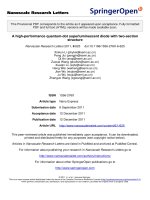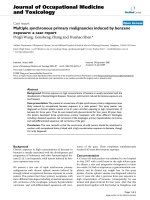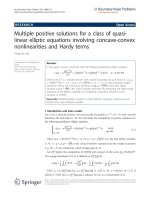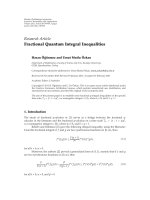Báo cáo hóa học: " Multiple Wavelength InGaAs Quantum Dot Lasers Using Ion Implantation Induced Intermixing" potx
Bạn đang xem bản rút gọn của tài liệu. Xem và tải ngay bản đầy đủ của tài liệu tại đây (216.62 KB, 4 trang )
NANO EXPRESS
Multiple Wavelength InGaAs Quantum Dot Lasers Using
Ion Implantation Induced Intermixing
S. Mokkapati Æ Sichao Du Æ M. Buda Æ L. Fu Æ H. H. Tan Æ C. Jagadish
Received: 27 August 2007 / Accepted: 6 September 2007 / Published online: 25 September 2007
Ó to the authors 2007
Abstract We demonstrate multiple wavelength InGaAs
quantum dot lasers using ion implantation induced inter-
mixing. Proton implantation, followed by annealing is used
to create differential interdiffusion in the active region of
the devices. The characteristics (lasing-spectra, threshold
currents and slope efficiencies) of the multi-wavelength
devices are compared to those of as-grown devices and the
differences are explained in terms of altered energy level
spacing in the annealed quantum dots.
Keywords Quantum dot lasers Á Ion implantation
Integration of several quantum dot (QD) devices on a
single chip offers the advantages of compact size, high
speed and low optical losses, added to the advantages
discrete QD devices offer due to three-dimensional carrier
confinement in the active region. Ion implantation induced
intermixing is a technique that is compatible with planar
processing and can be used for band gap tuning, essential
for device integration. Ion implantation induced intermix-
ing has been widely used for band gap tuning of quantum
wells [1, 2] (QW) and QDs [3–8]. QW based integrated
photonic devices have also been demonstrated using
implantation induced intermixing [9, 10]. Though there are
many reports on band gap tuning of QDs, there are no
reports to date on multi-color QD lasers using ion
implantation induced intermixing. In this letter, we report
on multi-wavelength QD lasers fabricated using implanta-
tion induced intermixing. We first demonstrate differential
band gap shift and effect on carrier confinement and energy
level spacing in QDs due to ion implantation induced
intermixing, using photoluminescence (PL). Then we
report on multi-color QD lasers and discuss the effect of
intermixing induced changes in confinement and energy
level separation in the active region on the performance of
the devices.
The thin p-clad laser structures studied in this work were
grown by metal-organic chemical vapor deposition
(MOCVD) system. Trimethylindium, trimethylgallium and
AsH
3
with H
2
as the carrier gas were used as the precursor
sources; Silane and CCl
4
were used as n- and p-type dopant
sources, respectively. The active region of the lasers con-
sisted of five layers of In
0.5
Ga
0.5
As QDs incorporated into
GaAs barrier layers. 100 keV protons at a dose of
5 · 10
13
cm
–2
were implanted into the active region,
wherever mentioned. Following implantation, the device
structures were annealed at 600 ° C for 30 min in the
presence of AsH
3
. Annealing conditions were chosen to
maximize the room temperature (RT) PL recovery from the
QDs in the active region. PL spectra from the active region
of the devices were obtained prior to device fabrication by
exciting the samples using a 635 nm laser and collecting
the luminescence using a cooled InGaAs detector. Four
micrometers wide ridge wave-guide lasers were fabricated
from the annealed and as-grown laser structures using the
standard device processing steps [11]. The as-cleaved
devices were tested at RT in pulsed mode (duty cycle 5%).
First, we present results demonstrating differential band
gap shift and the effect of annealing on the carrier con-
finement and separation between consecutive energy levels
S. Mokkapati (&) Á S. Du Á L. Fu Á H. H. Tan Á C. Jagadish
Department of Electronic Materials Engineering, Research
School of Physical Sciences and Engineering, The Australian
National University, Canberra, ACT 0200, Australia
e-mail:
M. Buda
National Institute of Materials Physics, Str. Atomistilor 105bis,
P.O. Box MG-7, Magurele 077125, Romania
123
Nanoscale Res Lett (2007) 2:550–553
DOI 10.1007/s11671-007-9097-x
in the QDs in the active region of the laser structure. Due to
larger effective mass of holes compared to that of elec-
trons, the hole energy levels are closely spaced than the
electron energy levels and holes are less confined than the
electrons in the as-grown sample. Interdiffusion has the
same effect on hole energy levels as that on electron energy
levels, but we only discuss the effect of interdiffusion on
carriers with higher confinement (electrons), as the device
performance is affected mainly by changes in electron
confinement rather than the hole confinement. Figure 1
shows the 10 K PL spectra from the active region of the
device structures annealed with and without implantation.
For the un-implanted region, the QD ground state (GS)
luminescence peaks at 1015 nm (P1). Due to enhanced
interdiffusion caused by proton implantation, the QD GS
luminescence peak (P1
0
) from the implanted region is blue
shifted with respect to peak P1 from the un-implanted
region. Under the implantation and annealing conditions
used in this study, the differential shift is *19 meV. Peaks
P2 and P2
0
represent QD excited state (ES) transitions in
un-implanted and implanted samples, respectively. The
wetting layer transitions appear at shorter wavelengths and
are denoted as P3 and P3
0
for the un-implanted and
implanted samples, respectively.
The carrier confinement in the active region of the
devices is determined by the separation between the GaAs
(barrier) band edge and the QD energy levels (E
conf
in
Fig. 1). Assuming a conduction band offset of 0.6E
g
, the
confinement energy for the electrons occupying the lowest
energy level in the conduction band of QDs in the as-grown
device structure is *230 meV (not shown), whereas the
confinement energy for the carriers occupying the GS of
QDs in the un-implanted and implanted, annealed devices
is *180 meV and 168 meV, respectively. Thermal
population of QD ES depends on the energy separation
between the GS and ES (DE in Fig. 1). The separation
between consecutive energy levels in the conduction band
calculated from the observed peaks in the PL spectra from
both implanted (P1
0
and P2
0
) and un-implanted (P1 and P2)
samples is *35 meV, which is very close to the thermal
energy of carriers at RT. These results indicate that the
carriers in the annealed quantum dots have smaller con-
finement energy and greater probability of occupying ES.
We now present results demonstrating multi-color lasing
from the QD lasers fabricated using ion implantation
induced intermixing and compare their characteristics with
as-grown devices. Figure 2 shows the lasing spectra of
2 mm long lasers fabricated from un-implanted and
implanted device structures. The lasing spectrum of an as-
grown device is also shown as a reference. The blue shift
between the spectra of as-grown device and annealed only
device is a result of interdiffusion due to background
(grown-in) defect levels, whereas the shift between the
annealed only device and device annealed after implanta-
tion is due to implantation induced differential band gap
shift. The spectra of implanted and un-implanted devices
are shifted with respect to each other by *40 meV. This
shift is greater than the shift in the QD PL peak positions
indicated by the dashed vertical lines in Fig. 1. It is also
interesting to note from Fig. 2 that the annealed devices
have broader lasing spectra compared to that of the as-
grown devices. Broad lasing spectra could be a conse-
quence of high injection current densities required for
lasing in the annealed devices [12].
Simultaneous lasing from different energy levels in QD
or QW lasers has been observed by several groups [13–16],
especially for short cavity lengths and was explained in
terms of high cavity losses, which lead to increase in
Fig. 1 Photoluminescence spectra at 10 K from the active region of
the device structures annealed with or without implantation. Inset
schematically defines the energy terms (DE and E
conf
) used in the text
Fig. 2 Lasing spectra of 2 mm long lasers fabricated from as-grown;
un-implanted, annealed and implanted, annealed device structures.
Inset shows lasing spectra of 1 mm long laser fabricated from
implanted and un-implanted, annealed device structures
Nanoscale Res Lett (2007) 2:550–553 551
123
threshold and thus to increased band filling [15]. Increasing
the operation temperature would also require higher
injection and leads to the same effect [16]. At RT, the as-
grown devices studied in this work lase from QD GS for all
cavity lengths whereas the annealed devices show simul-
taneous lasing from different energy levels (for
L £ 1.5 mm for un-implanted and L £ 2 mm for implanted
devices). Inset in Fig. 2 shows the lasing spectra of 1 mm
long devices fabricated from annealed device structures
(with or without implantation). As will be discussed later,
the annealed devices have higher thresholds (consequence
of smaller E
conf
and DE) leading to increased band filling.
Also, smaller values of DE in the annealed QDs increase
the probability of thermal population of higher energy
levels. So we attribute simultaneous lasing from different
energy levels in the annealed devices to modification of
energy level separation in the active region, as a conse-
quence of annealing.
Figure 3 shows the threshold current densities of as-
grown, un-implanted, annealed and implanted, annealed
devices. The implanted and un-implanted devices have
similar threshold current densities, suggesting that at the
implantation conditions used, there are no additional
residual defects in the implanted devices after annealing.
The annealed (both implanted and un-implanted) devices
have higher threshold current densities than the as-grown
devices for any given cavity length. The annealed devices
also have lower slope efficiencies than the as-grown
devices (inset of Fig. 3). From 5 °Cto20°C, the slope
efficiency of a 3 mm long un-implanted, annealed device
changes by 89%, while that of an as-grown device of same
length changes by only 30% by increasing the temperature
from 5 °Cto55°C. The smaller separation between con-
secutive energy levels (DE) in the annealed QDs cause loss
of carriers from lower (lasing) energy states to higher
energy states, reducing the net gain available from these
states. Increased thermal population of higher energy states
in the barrier/WL (smaller values of E
conf
) increases the
fraction of injected carriers that can access non-radiative
recombination paths [17]. The loss of carriers from the
lasing states to higher energy levels in the QDs/WL/barrier
results in increased threshold currents and lower slope
efficiencies in the annealed devices. The fraction of carriers
lost from the lasing states to states that do not contribute
to lasing increases with increasing temperature as [exp
(–E/k
B
T)], where E is the energy separation between the
lasing and non-lasing energy states. The rate of loss of
carriers is higher in annealed samples because of smaller
values of DE and E
conf
, resulting in a rapid decrease in the
slope efficiency with temperature, compared to the as-
grown sample.
The above results indicate that smaller values of DE and
E
conf
in the multiple-wavelength devices result in poor
performance compared to the as-grown devices. Improve-
ment in device performance has been reported by
engineering the QD energy levels [18] (to increase DE) and
using AlGaAs barriers [19] (to increase E
conf
). We believe
that using similar approaches with implantation induced
intermixing may result in multi-color lasers with improved
characteristics.
In summary, we have demonstrated multiple wavelength
InGaAs QD lasers using ion implantation induced inter-
mixing. For a cavity length of 2 mm, the shift in the lasing
wavelength of un-implanted and implanted devices is
40 meV. Implantation followed by annealing of device
structures used for achieving differential band gap shift
alters the energy level spacing in the active-region,
resulting in broader lasing spectra, higher threshold current
densities and lower slope efficiencies with respect to the as-
grown devices. Hence band gap tuning using ion implan-
tation induced intermixing requires careful design of
devices to minimize carrier loss from the QD active region.
Thanks are due to Marie Bruneau, Michael Aggett for
expert technical advice. The Australian Research Council
is gratefully acknowledged for the financial support.
References
1. P.G. Piva, P.J. Poole, M. Buchanan, G. Champion, I. Templeton,
G.C. Aers, R. Williams, Z.R. Wasilewski, E.S. Koteles, S.
Charbonneau, Appl. Phys. Lett. 65, 621 (1994)
2. S. Charbonneau, P.J. Poole, Y. Feng, G.C. Aers, M. Dion, M.
Davies, R.D. Goldberg, I.V. Mitchell, Appl. Phys. Lett. 67, 2954
(1995)
3. T. Surkova, A. Patane
`
, L. Eaves, P.C. Main, M. Henini, A. Pol-
imeni, A.P. Knights, C. Jeynes, J. Appl. Phys. 89, 6044 (2001)
4. B. Salem, V. Aimez, D. Morris, A. Turala, P. Regreny, M.
Gendry, Appl. Phys. Lett. 87, 241115 (2005)
Fig. 3 Threshold current density versus cavity length for as-grown;
un-implanted, annealed and implanted annealed lasers. Inset shows
the output power (L) versus injected current (I) plots for as-grown and
annealed devices (cavity length: 3 mm)
552 Nanoscale Res Lett (2007) 2:550–553
123
5. S. Fafard, C. Nı
`
. Allen, Appl. Phys. Lett. 75, 2374 (1999)
6. P. Lever, H.H. Tan, C. Jagadish, P. Reece, M. Gal, Appl. Phys.
Lett. 82, 2053 (2003)
7. S. Barik, H.H. Tan, C. Jagadish, Appl. Phys. Lett. 88, 223101
(2006)
8. C. Dion, P. Desjardins, M. Chicoine, F. Cshiettekatte, P.J. Poole,
S. Raymond, Nanotechnology 18, 015404 (2007)
9. H.H. Tan, C. Jagadish, Appl. Phys. Lett. 71, 2680 (1997)
10. S. Charbonneau, P.J. Poole, P.G. Piva, G.C. Aers, E.S. Koteles,
M. Fallahi, J.J. He, J.P. McCaffrey, M. Buchanan, M. Dion, R.D.
Goldberg, I.V. Mitchell, J. Appl. Phys. 78, 3697 (1995)
11. M. Buda, J. Hay, H.H. Tan, J. Wong-Leung, C. Jagadish, IEEE J.
Quantum Electron. 39, 625 (2003)
12. M. Sugawara, N. Hatori, H. Ebe, M. Ishida, Y. Arakawa, T.
Akiyama, K. Otsubo, Y. Nakata, J. Appl. Phys. 97, 043523
(2005)
13. L.F. Lester, A. Stintz, H. Li, T.C. Newell, E.A. Pease, B.A.
Fuchs, K.J. Malloy, IEEE Photon. Tech. Lett. 11, 931 (1999)
14. F. Karouta, E. Smalbrugge, W.C. van der Vleuten, S. Gaillard,
G.A. Acket, IEEE J. Quantum Electron. 34, 1474 (1998)
15. M. Mittlestein, Y. Arakawa, A. Larsson, A. Yariv, Appl. Phys.
Lett. 49, 1689 (1986)
16. P.S. Zory, A.R. Reisinger, R.G. Waters, L.J. Mawst, C.A.
Zmudzinski, M.A. Emanuel, M.E. Givens, J.J. Coleman, Appl.
Phys. Lett. 49, 16 (1986)
17. D.G. Deppe, D.L. Huffaker, S. Csutak, Z. Zou, G. Park, O.B.
Shchekin, IEEE J. Quantum Electron. 35, 1238 (1999)
18. O.B. Shchekin, G. Park, D.L. Huffaker, D.G. Deppe, Appl. Phys.
Lett. 77, 466 (2000)
19. S.V. Zaitsev, N.Y. Gordeev, V.I. Kopchatov, V.M. Ustinov, A.E.
Zhukov,A.Y. Egorov, N.N.Ledentsov, M.V. Maximov, P.S. Kop’ev,
A.O. Kosogov, Z.I. Alferov, Jpn. J. Appl. Phys. 36, 4219 (1997)
Nanoscale Res Lett (2007) 2:550–553 553
123









